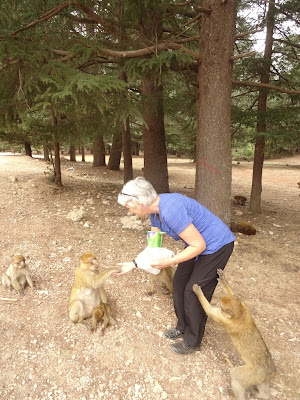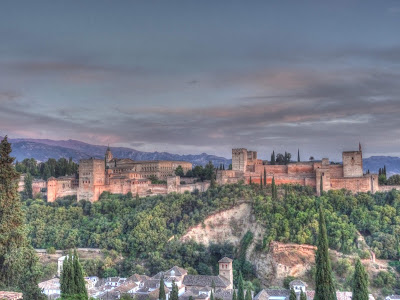Morocco
We left Europe from Tarifa, Spain, to get to Morocco. Tarifa is the southern most city in Europe and is located where the Mediterranean and the Atlantic Ocean meet. We went to Tarifa solely for a ferry ride across the Straits of Gibraltar, but we are happy to have visited this southernmost city.
Once we departed the ferry in Tangiers, we knew we were in a different world and not one we were well prepared for. Morocco has their own currency and we didn’t have any of theirs. Booking train tickets at the train station with a credit card didn’t work, so we improvised a walking discovery tour to find a bank to use an ATM. Spanish is not even a third language of the people of Morocco, but French is (remember the movie Casablanca?). Our linguist Jan fortunately lived for a few months in France 40 years ago and knew enough French to get us by.
We got our tickets and waited for our train to Fez, the place in Morocco we’d singled out as the best destination. Being surrounded by Muslims in a relatively poor country is a little disconcerting. We seemed to be the only foreigners in a large train station, and we stood out due to our clothing and western luggage and probably a few other things.
It was a four and a half (4 1/2) hour train ride through some barren countryside and cities that reminded me of the Korea we lived in and knew 40 years ago - not too enticing! We read of some of the things to beware of in this strange country, so we were not at ease. There are several do’s and don’ts regarding food, getting help, and how to behave, and the first hours had our imaginations primed for problems.
Fortunately, Jan had booked a very good Ryad (hotel), and when we finally got there, the atmosphere was very welcoming.
The hotel, like most, is not all that inviting from the outside, as most of the buildings are windowless on the ground floor. But they have large and beautiful courtyards that are part sanctuary. Add to the courtyard the very friendly and helpful owners and all of their staff, and suddenly things got much better. We have our dinners and breakfasts at the Ryad, partly because the hygiene is trustworthy. The food is excellent and also authentic Moroccan.
With comfort addressed by the people running the fine Ryad Mabrouka, we could focus on exploring Morocco. Our first day was spent with a guide who showed us the old city, or Medina. The first thing he informed us of was that Morocco was the first country to recognize the United States as a country after our forefathers won the Revolutionary War. It was a little hard to believe, but I looked it up, and it’s true.
The always prevalent thing you notice here are the minarets and mosques. 99% of the population is Muslim, and religion is part of their education as well as their day-to-day life. We hear the calls to prayer five times each day, especially in the evenings - a call announced from every minaret. While most mosques only allow Muslims, our guide took us to one that admits infidels, like the four of us.
Normally one takes shoes off when in a mosque and washes their hands and feet. They are quite interesting and beautiful places.
Fez is a city of 2 million people and was once the capital of Morocco. The Medina where we are living has no car transportation, in part because the streets are usually no more than 12 feet wide, and frequently 4-5 feet wide. There are 9,400 such streets in the Medina, so a guide is essential if you don’t wish to get lost!
We somehow managed to arrive during the festival of the sheep, an annual holiday when a sheep is sacrificed to God, just as it was done by Abraham in the Old Testament. There are live sheep everywhere, and transporting them is a three-ring circus. There are people walking them, putting them in taxis, carrying them on the backs of motorcycles, and even on the tops of their vehicles. All sheep are alive when these pictures are taken!
It is kind of like our Thanksgiving, except the sheep is the main dinner item. And, it is a bit like Christmas because the children are given new clothes and gifts.
While on the topic of animals, one seen in Fez is the stork. You probably know a little about the stork, and perhaps most of what you know is thanks to the fairy tales that said they delivered babies. Storks are a sacred animal in Morocco since they eat snakes. We didn’t see a single snake, but several storks.
They are migratory birds and travel to and from Europe to select parts of Africa.
An animal that we more often associate with Africa is the monkey. We didn’t think Morocco would have any, but we not only learned otherwise, we also saw them and fed some when we hired a driver to take us to the Atlas Mountains. They are called barbary macaques and are one of the few monkey species to dwell in a cold and snowy climate. We were well armed with a bag of nuts and made a lot of good friends until the nuts ran out.
We had a rich introduction to the crafts of the Moroccan culture. Many things are handcrafted here, including wool carpets, leather goods made from lamb, and pottery. The sales people of these goods are quite good, but they are very willing to bargain. Jan, our language specialist, was also our queen of bargaining. The most challenging was Abdul the rug dealer shown here at the left side of the picture.
My favorite was the pottery crafts people and how they assemble thousand of little pieces when making table tops and water fountains. I still remember the barely recognizable clay ash tray I made in art class and know they are talented and patient.
The food has been very good, and many things were brand new to us. The next picture shows skewers of chicken and lamb, along with a chicken cooked in a clay pot. We also had flakey-dough pot pies filled with pigeon, with the outside dusted in powdered sugar and cinnamon.
We have been in Morocco for three full days and have seen much. We expected that we would see a different world, and we did. We can now claim to have set foot in Africa, but it was just one of many unique parts of Africa.
Tomorrow we head to Casablanca to catch a flight to Madrid, Spain. Our days of being tourists is coming to an end. This last shot is of the leather tanning vats in Fez.

















































